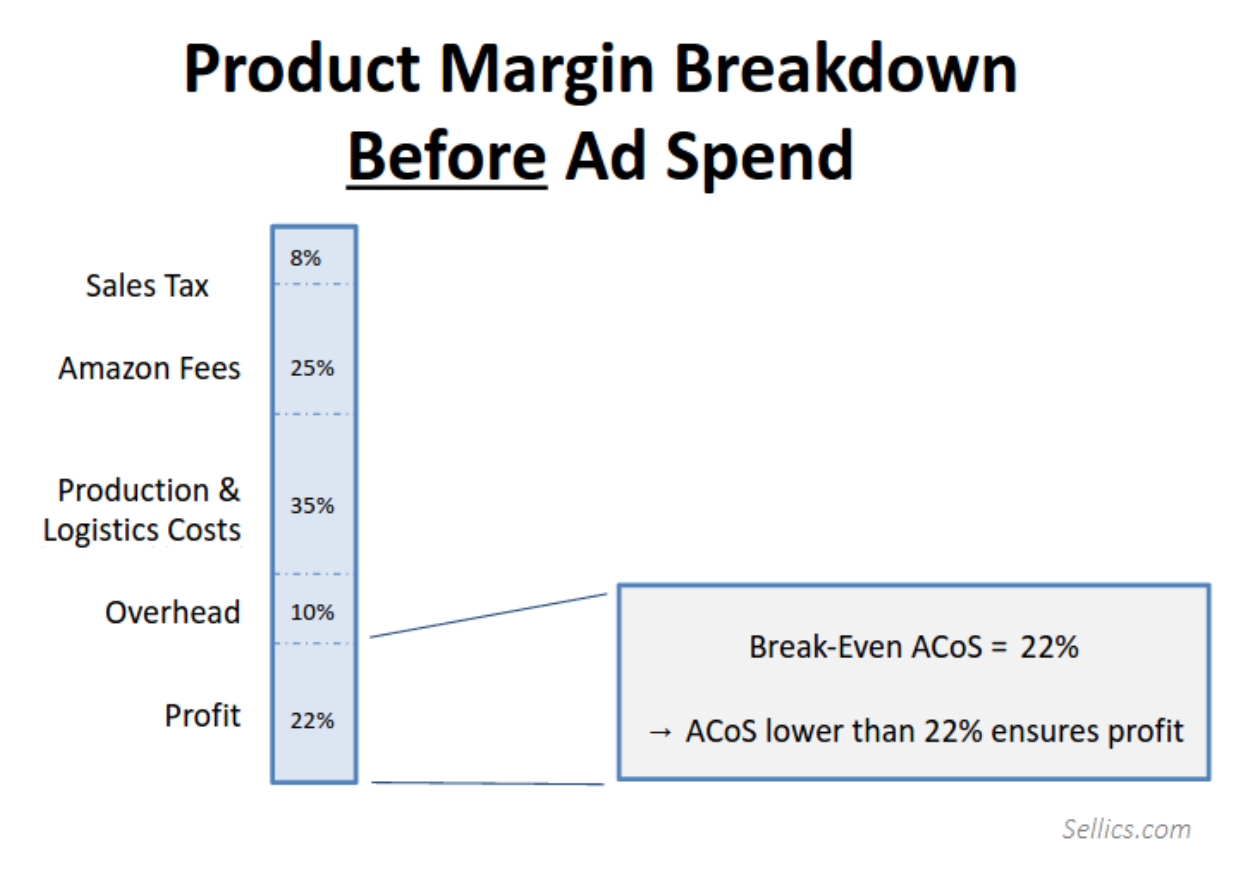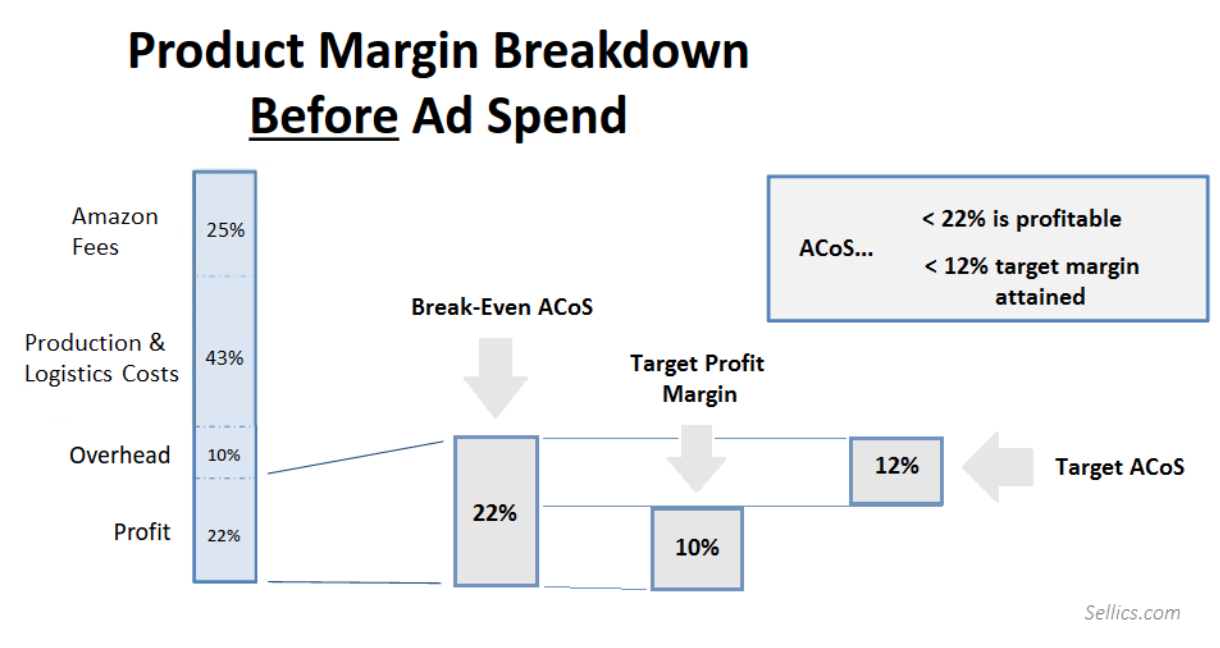Do your Amazon Sponsored Products campaigns have the right ACoS?
Most sellers measure the success of their Amazon Sponsored Products campaigns (“Amazon PPC”) by looking at the Advertising Cost of Sales (“ACoS”). The ACoS indicates how much you spend on ads for each dollar of sales generated through ads (ACoS = ad spend / sales generated through ads). Most sellers don’t target an exact number for their ACoS. Instead, they only focus on lowering their ACoS. However, depending on your goals, lowering the ACoS may not be the right thing to do.
The right ACoS depends on your strategy
There are two common strategies when it comes to Amazon PPC. The first strategy is to use Sponsored Products to improve the organic rankings of the product. The idea is to use ads to increase sales velocity which in turn will improve organic rankings. Hence, the goal of this strategy is to sell as many units through ads as possible while not making any losses. This strategy is commonly used for new products without track-record on Amazon.
The second strategy is to use Sponsored Products to generate as much profit as possible. This strategy is typically used in a later stage of a product when it already has good organic rankings.
Whether a certain ACoS is good or bad depends on the strategy you are pursuing. An ACoS of 20% may be good if your main goal is to maximize sales velocity but may be bad if you aim at maximizing profits. Thus, you first need to decide on the strategy for each campaign. Depending on the strategy you then need to calculate either the “break-even ACoS” or the “target ACoS” in order to assess whether a certain ACoS is good or bad.
Determining break-even ACoS to maximize your sales
The break-even ACoS is the ACoS where you won’t lose any money. As long as you spend less on advertising than your profit margin, you won’t incur a loss. The profit margin is the amount you make after deducting all costs. Let’s look at the following example:

As you can see, the profit margin before ad spend is 22%. This means that you can invest up to 22% of the product’s price in ads without making a loss. Hence, the break-even ACoS is 22%.
If your strategy is to maximize sales velocity you want to invest as much as possible into ads as long as you don’t lose any money. Therefore, the goal for your campaign should not be to reduce the ACoS as much as possible but to generate as many sales as possible with an ACoS of 22% (the break-even ACoS). Obviously, you could also invest less than the break-even ACoS but then you would miss out on sales.
Determining target ACoS to generate your target profit margin
If you are following the second strategy i.e. using Sponsored Products to make profits, break-even ACoS should not be the ACoS that you’re looking at. Instead, you should define a target margin that you want to achieve after ad spend. Let’s look at another example:
 In this example, the product has a margin of 22% again i.e. your break-even ACoS is 22%. Let’s assume that you want to have a net profit margin after ad spend of 10%. This means that you can spend up to 12% of the product’s price on ads. This equals your “target ACoS”. If you manage to bring your ACoS down to your target ACoS or even less you will make the profit margin you’ve targeted.
In this example, the product has a margin of 22% again i.e. your break-even ACoS is 22%. Let’s assume that you want to have a net profit margin after ad spend of 10%. This means that you can spend up to 12% of the product’s price on ads. This equals your “target ACoS”. If you manage to bring your ACoS down to your target ACoS or even less you will make the profit margin you’ve targeted.
In some cases, losing money through Sponsored Products is acceptable
Besides the two strategies mentioned above, there are some situations where it may be acceptable to have an ACoS that is higher than your break-even ACoS (i.e. losing money on every sale you make through ads). Here are a few examples:
- Selling excess inventory: If you want/need to clear your inventory as quickly as possible it may make sense to accept higher ACoS. For example, as an FBA seller, Amazon will charge you long term storage fees if you keep units in stock for more than 6 months. It could be cheaper to sell those products at a loss through Sponsored Products than to pay the additional storage fee.
- Raising brand awareness: If brands want to increase their brand awareness the main goal is to rank on the first page for all important keywords of a specific product category. In those cases, they will accept a higher ACoS as the visibility alone creates more value than the loss on the products sold.
- Launching new products in highly competitive niches: Some niches could be too competitive to generate sales at the break-even ACoS. In this case, it may make sense to accept losses in order to get the ball rolling.
Note that those are all situations that are limited in time. It is not advisable to run PPC campaigns at an ACoS higher than your break-even ACoS for longer than necessary.
Use Sellics to optimize your Amazon Sponsored Products campaigns
Sellics is a powerful Amazon Sponsored Products Management Software that allows sellers to manage and optimize their PPC campaigns. Sellics also offers other features that help sellers boost their success on Amazon: A live profit dashboard, inventory management, keyword ranking optimizer and more. All tools are conveniently integrated in one powerful suite. Try our 14-day free trial.

About the author
Franz is founder and CEO of Sellics.